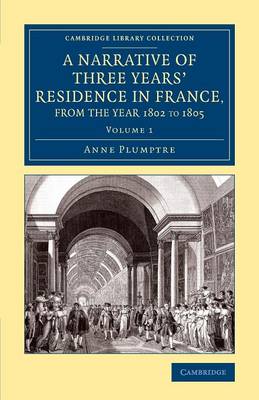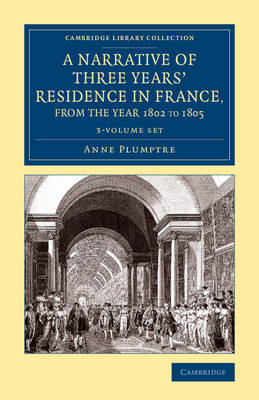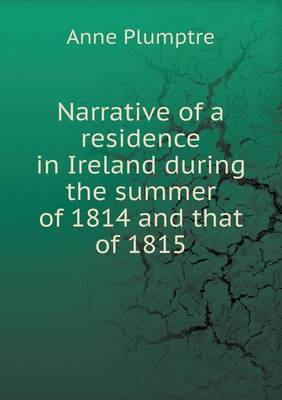Cambridge Library Collection - Travel, Europe
1 primary work • 6 total works
Volume 1
The writer and translator Anne Plumptre (1760–1818) and her sister Annabella, also a writer, divided their time between Norwich and London, where they moved in radical and dissenting circles. Anne also travelled abroad, publishing this three-volume description of three years' residence in France in 1810. (Her 1817 volume on Ireland is also reissued in this series.) Like many other Britons, Plumptre took the opportunity of the Peace of Amiens to visit post-revolutionary France, and she stayed in the country until hostilities recommenced in 1805. Sympathetic to the revolution, she intended to examine for herself the state of the country and its people, and compare her first-hand impressions (especially of Napoleon) with the generally hostile information about France then currently available in Britain. Volume 1 describes her stay in Paris (where she was accidentally locked in the ruins of the Bastille at nightfall), and her journey to Marseilles via Lyons.
The writer and translator Anne Plumptre (1760-1818) and her sister Annabella, also a writer, divided their time between Norwich and London, where they moved in radical and dissenting circles. Anne also travelled abroad, publishing this three-volume description of three years' residence in France in 1810. (Her 1817 volume on Ireland is also reissued in this series.) Like many other Britons, Plumptre took the opportunity of the Peace of Amiens to visit post-revolutionary France, and she stayed in the country until hostilities recommenced in 1805. Sympathetic to the revolution, she intended to examine for herself the state of the country and its people, and compare her first-hand impressions (especially of Napoleon) with the generally hostile information about France then currently available in Britain. Volume 1 describes her stay in Paris, and journey south; Volume 2 is based at Marseilles, and Volume 3 covers her return to England via Bordeaux and Brittany.
The writer and translator Anne Plumptre (1760-1818) and her sister Annabella, also a writer, divided their time between Norwich and London, where they moved in radical and dissenting circles. Anne also travelled abroad, publishing this three-volume description of three years' residence in France in 1810. (Her 1817 volume on Ireland is also reissued in this series.) Like many other Britons, Plumptre took the opportunity of the Peace of Amiens to visit post-revolutionary France, and she stayed in the country until hostilities recommenced in 1805. Sympathetic to the revolution, she intended to examine for herself the state of the country and its people, and compare her first-hand impressions (especially of Napoleon) with the generally hostile information about France then currently available in Britain. Volume 3 describes Plumptre's travels through western France on her way home, and ends with a long section on the character and deeds of Napoleon.
The writer and translator Anne Plumptre (1760-1818) and her sister Annabella, also a writer, divided their time between Norwich and London, where they moved in radical and dissenting circles. Anne also travelled abroad, publishing this three-volume description of three years' residence in France in 1810. (Her 1817 volume on Ireland is also reissued in this series.) Like many other Britons, Plumptre took the opportunity of the Peace of Amiens to visit post-revolutionary France, and she stayed in the country until hostilities recommenced in 1805. Sympathetic to the revolution, she intended to examine for herself the state of the country and its people, and compare her first-hand impressions (especially of Napoleon) with the generally hostile information about France then currently available in Britain. In Volume 2, Plumptre is based at Marseilles, and describes both the city and its recent history during the Reign of Terror; she then travels to Aix-en-Provence.
The writer and translator Anne Plumptre (1760-1818) and her sister Annabella, also a writer, divided their time between Norwich and London, where they moved in radical and dissenting circles. Anne also travelled abroad, publishing this three-volume description of three years' residence in France in 1810. (Her 1817 volume on Ireland is also reissued in this series.) Like many other Britons, Plumptre took the opportunity of the Peace of Amiens to visit post-revolutionary France, and she stayed in the country until hostilities recommenced in 1805. Sympathetic to the revolution, she intended to examine for herself the state of the country and its people, and compare her first-hand impressions (especially of Napoleon) with the generally hostile information about France then currently available in Britain. Volume 1 describes her stay in Paris (where she was accidentally locked in the ruins of the Bastille at nightfall), and her journey to Marseilles via Lyons.
Narrative of a residence in Ireland during the summer of 1814 and that of 1815
by Anne Plumptre
Published 1 February 2012
The writer and translator Anne Plumptre (1760-1818) and her sister Annabella, also a writer, divided their time between Norwich and London, where they moved in radical and dissenting circles. Anne also travelled abroad, publishing a three-volume description of three years' residence in France (also reissued in this series) in 1810, and this work on Ireland in 1817. The first part describes a journey to Dublin in 1814, the city and its society, and the counties of Antrim, Down and Wicklow, and the second a further visit which included Dublin, Cork, the lakes of Killarney, and Limerick. Plumptre states that her 'constant aim has been to examine every object with accuracy, to pursue every inquiry with impartiality', and though the book is full of descriptions of landscape and literary associations, Plumptre also gives her views on the current political state of the country and the nature of its people.



